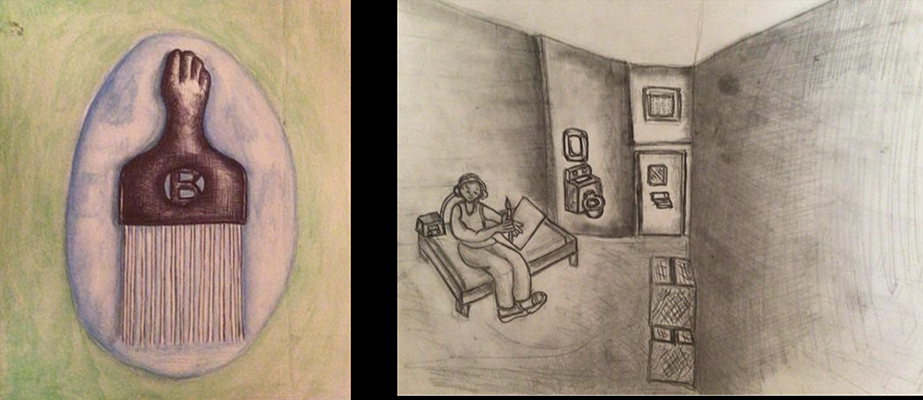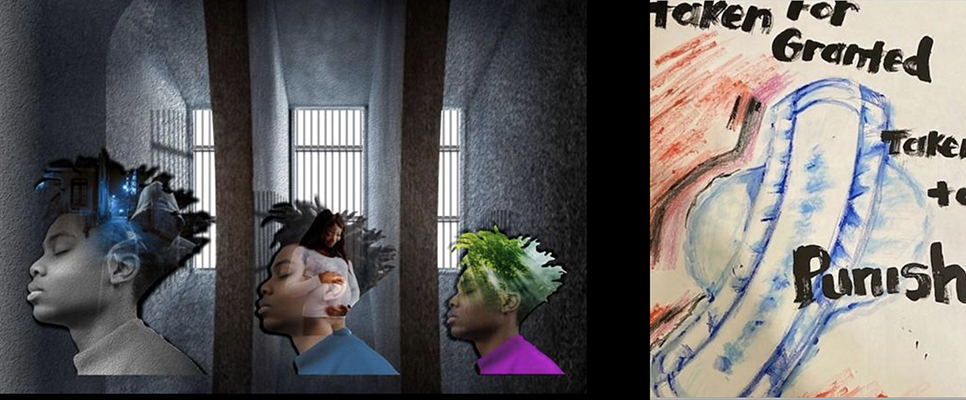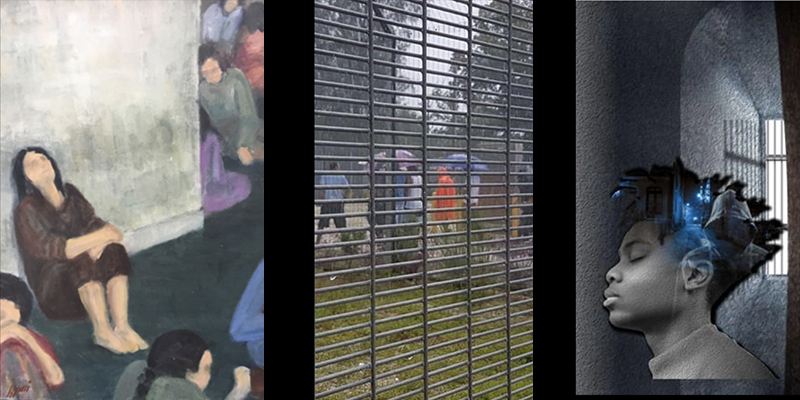The 18+ works have been created by eight formerly incarcerated artists, who came together last year in a project led by Iranian artist-architect-activist Nasrin Navab as part of a program funded by the Mellon Foundation through the Humanities Research Institute at UIUC. The participants represent a diversity of genders, ages, “offenses,” nationalities, races and cultures, each with their own experience of surveillance, policing, ICE and incarceration. The prisons they spent time in cross the globe, from Illinois to Iran to Manus Island, which holds a detention facility off Australia.

Image: Manus Island Australia, 2016. © Imran Mohammad. Courtesy of the artist.
Navab has long taught and created, as urbanist architect, painter, and teacher, with the theme of “art making as a pedagogy of solidarity.” Through ongoing and probing conversations, the eight artists represented have created works around objects they desired while incarcerated, as well as those that connected them with outside life. The installations include soundscapes, banned smells, and images that can be seen only in a mirror.
Photo courtesy of Nasrin Navab.
A number of the artists will be at the opening from 1-3 on Friday, February 11 in the Hood Classroom on the lower level of KAM, as part of a conversation led by artist Sarah Ross.

Images: (Left) Vincent Robinson. Objects, Brush, 2021. Mixed Media. ©Vincent Robinson(. Right) Tomb, 2021. Pencil drawing on paper. ©Vincent Robinson. Images courtesy of the artist.
Navab herself spent more than three years in the notorious Evin Prison in Iran. Detained in 1983 at age 25, she was tortured and held in conditions with a large number of women, some high school students as young as 14 or 15. Evin Prison was built in 1972 specifically to house political prisoners before trial, but many were held there for years — or executed — before any charges were brought. They were accused of “religious violations” following the uprising of 1979 when there were widespread protests against an increasingly restrictive and violent regime. With power passing to Khomeini the unrest continued and large numbers of student protesters were swept up by the government.

Nasrin Navab, Evin, Ward 4, 1989. Oil on canvas. © Nasrin Navab. Image courtesy of the artist.
Navab’s painting Evin, Ward 4, details above, is a chilling representation of that time. After release, she managed to reach the United States where some of her family had already fled. She had been separated in imprisonment from her husband, who had difficulty leaving Iran.
Navab had completed a masters in architecture at the University of Tehran two years before she was imprisoned. She has worked as an architect both in Iran and the United States. In 2017 she participated under the same Mellon Grant in the U of I symposium that resulted in the Illinois Open Publishing Network’s Constructing Solidarities for a Humane Urbanism.
With her sister Nahid, Navab has mounted several exhibits of paintings on these themes around the country, including KAM. The upcoming show includes work by Vincent Robinson, Kenneth Norton, Monica Cosby, Lauren Stumblingbear, Imran Mohammad, Pablo Mendoza, Sarah Ross, and Nasrin Navab. (below

Images: Left: Kenneth Norton, Reflection, 2021. Digital art. © Kenneth Norton. Image courtesy of the artist. Right: Lauren Stumblingbear, Objects, Pad, 2021. © Lauren Stumblingbear. Image courtesy of the artist.
During the course of the exhibit, there will be a number of presentations expanding on its themes. Iranian-American playwright and poet Ezzat Goushegir, resident playwright of Chicago, has adapted her work, My Name is Inanna, for a staged reading at KAM on Saturday, February 18, with acclaimed actor Maryam Abdi, also Iranian-American, who created the character in the October 2021 production at the Red Tape Theatre in Chicago. Navab was moved by this performance, and asked them to come to Champaign/Urbana.
The play is based on the mythical character of Inanna, the Sumerian goddess of love, justice, civilization, and war, reinterpreted as a contemporary Middle Eastern woman who has been imprisoned in her country and flees to America. She struggles to establish herself in a hostile foreign country, at a time when American democracy is experiencing its own crisis under the impacts of war, discrimination, policing and carceral abuses.
Photos: Left, Ezzat Goushegir; right, Maryam Abdi. Photos courtesy of the artists.
Additional events will include a poetry night on Thursday, March 3, in solidarity with people in Iraq struggling for freedom of speech, as part of the poets’ and artists’ coalition, “Al Mutanabbi Street Starts Here,” that holds public art and book exhibits across the globe in response to the U.S. destruction of Baghdad literary quarters in Iraq.
Reckless Law, Shameless Order: An Intimate Experience of Incarceration
February 11th-April 2nd
Krannert Art Museum
Hood Classroom, lower level
500 E Peabody, Champaign
Make your reservation online.
Additional events:
Opening Reception; February 11th, 1-3 p.m.,
Performance of My Name is Inanna, a play by Ezzat Goushegir, the resident playwright of Chicago, performed by Maryam Abdi: February 18th, 1-3 p.m.
Poetry reading: Thursday March 3rd, details to be announced.
Evening of storytelling by the artists and closing celebration: Thursday March 24th, details to be announced.








